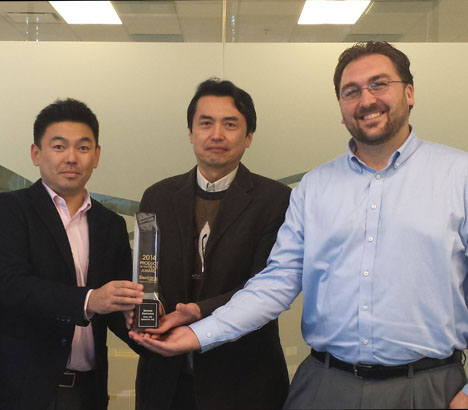The editorial team for Product of the Year discovered a number of products in the automotive ADAS arena that were interesting. In the end we chose two that were definitely leading the charge to this new mode of automotive safety. The Renesas R-Car V2H SoC, rated for 7,000 DMIPS, starts with a Cortex-A15 dual-core CPU and adds six IMR channels for viewpoint conversion processing, an IMP-X4 core with six programmable image processing accelerators for fourth-generation image recognition, and a 3D graphics core.
Renesas began working to create an ADAS-focused SoC in 2012. The marketing and sales teams collected requirements globally from automotive customers, and this feedback drove many of the design decisions. From a hardware standpoint, the teams identified image processing accelerators, functional safety features, additional camera inputs, and Ethernet AVB, for additional sensor data, as key needs.
The design teams began by looking at the earlier R-Car H2 infotainment chip, which had some ADAS features. “When it came to software we knew that reliability and security were two key RTOS criteria for production solutions,” Yoshihiro Kubo, Co-Section Manager, Global ADAS Solution Group, Renesas Electronics Europe told me. He also noted that customers indicated support for open image processing standards such as OpenCV and OpenVX. Image processing libraries were designed to take optimal advantage of various image processing accelerators and work with leading automotive safety and security RTOSs, as well as Linux.

Mitch Ohyamada, Assistant Manager, Renesas Electronics; Shigetatsu Katori, Senior Specialist, Renesas Electronics; Craig Johnson, Senior Manager, Renesas Electronics America
“When you are driving innovation, there are usually a few interesting challenges along the way, and this was the case while designing the R-Car V2H,” said Yoshihiro. One interesting challenge was finding Ethernet AVB-supported peripherals such as switches and low latency cameras to demonstrate the hardware-accelerated Ethernet AVB solution. As Ethernet AVB is a relatively new specification, there were no production solutions and very few development solutions. Another challenge was to properly balance the functional safety features versus cost. To meet the highest level of functional safety requirements, the CPU core and other processing blocks must be duplicated and run in lock step. There are a number of challenges in making a lock step ARM core, and die cost is one of the major challenges. The R-Car V2H was developed to provide an optimized and balanced combination of functional safety, performance, and costs to meet customer design requirements.
Advertisement
Learn more about Electronic Products Magazine





